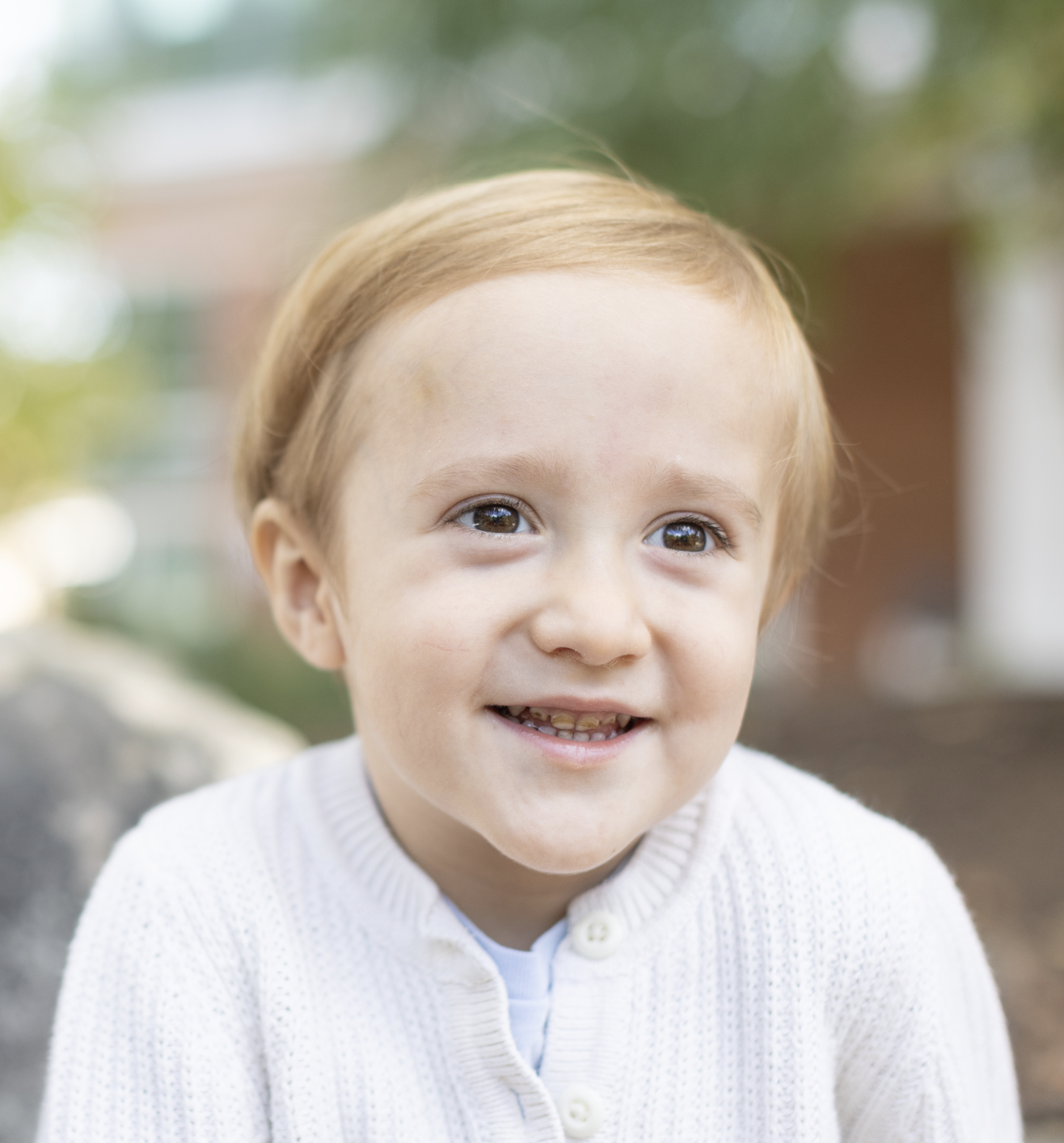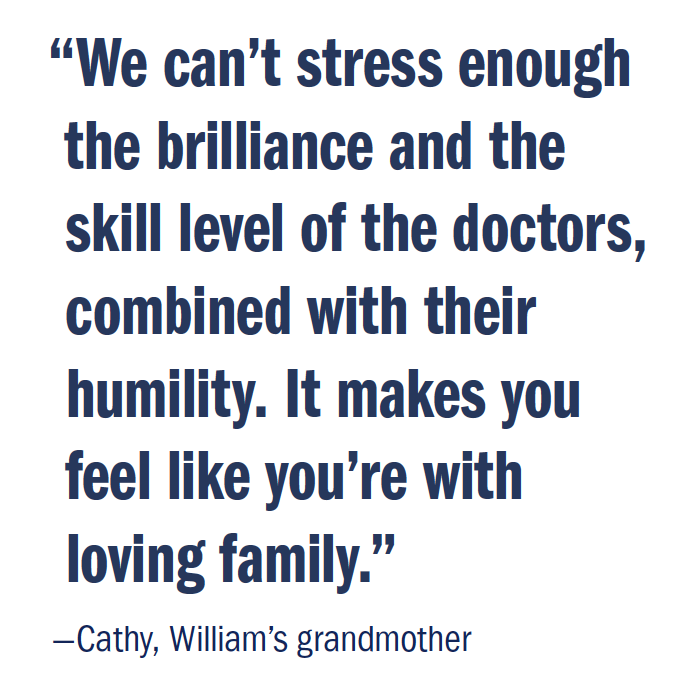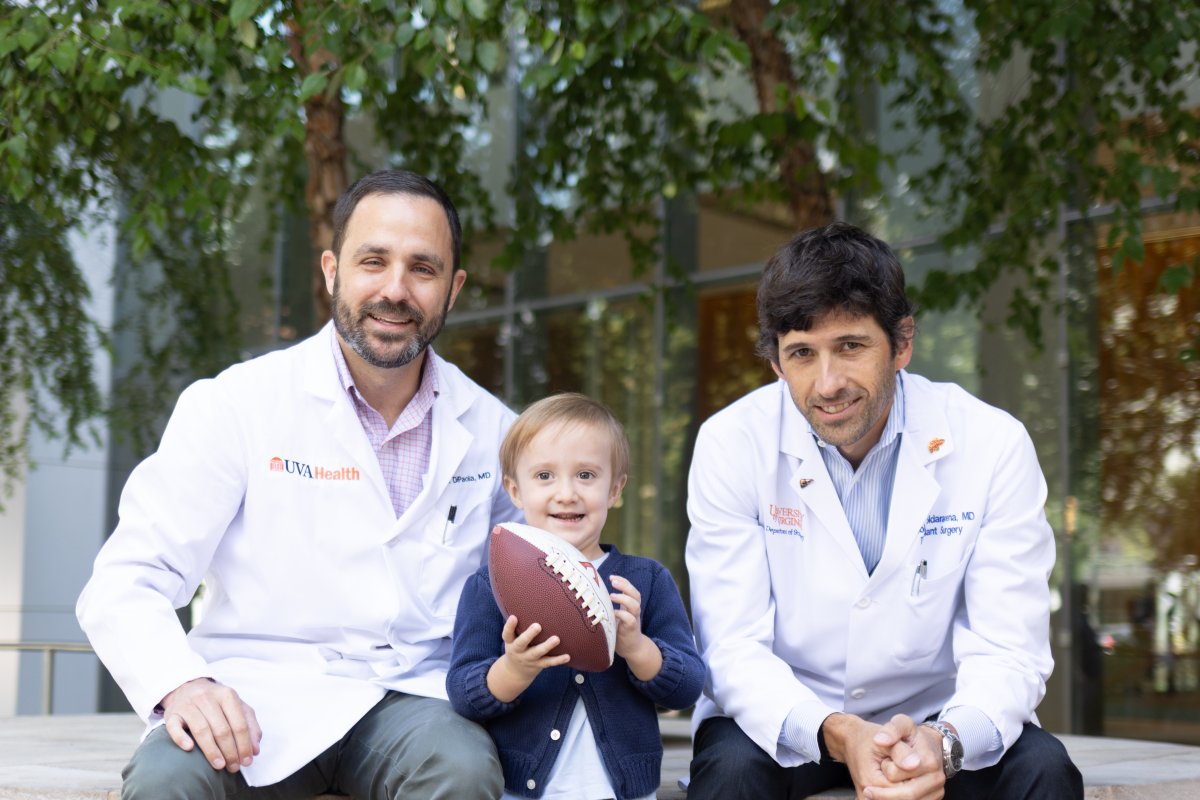Beyond a Gift
UVA Health Children’s performed life-saving transplant.
In December 2022, William Bell lay in a crib in the PICU at UVA Health Children’s. His mother, Maria, made her own makeshift bed to stay by his side. For three weeks, amid a welter of monitors, tubes, and wires, she held his hand, never letting go, through the long nights and hectic days.
Just two months shy of his 2nd birthday, William was in the PICU recovering from over six hours of surgery. When he was just a few weeks old, he was diagnosed with biliary atresia, a rare liver disease that affects approximately 1 in 15,000 babies in the U.S. each year. It has no known cause and no cure. If caught early in infancy, it can be treated with surgical intervention and, if necessary, a liver transplant.
William received an anonymous, non-directed living donor liver transplant in December 2022. His successful surgery and rapid recovery in the PICU are a testament to 2-year-old William’s fighting spirit and to the extraordinary efforts of a team of doctors, nurses, and medical professionals at UVA Health.

HEEDING THE WARNING SIGNS
By the time William received his transplant, he had endured more medical emergencies and invasive procedures than most adults do in a lifetime. His parents, Maria and Ryan Bell, attribute his outcome not just to the care he received at UVA but to an early series of lifesaving observations by healthcare professionals along the way.
“Many babies don’t receive surgical intervention because they aren’t diagnosed in time,” Maria said from her home in Fairfax County. “We’re incredibly thankful that wasn’t the case for William because of his pediatrician here, Dr. Timothy O’Mara. William’s good outcome today is a direct result of Dr. O’Mara, who saw that something just wasn’t right, knew what to do, and acted to put him on the path that led us to UVA to be under the care of Dr. Frank DiPaola, William’s hepatologist.
“One of the major signs was that he already had an obliterated gallbladder, and there was no bile flow from his liver,” Maria said. “At that point, he was transferred to UVA Medical Center and placed in the care of their pediatric gastroenterology and hepatology program.”
After further evaluation with Dr. DiPaola, and consultation with the surgical team led by Dr. Daniel Levin, the doctors were confident in their diagnosis of biliary atresia. A week later, Levin’s team performed what’s known as a Kasai procedure on William, giving his liver a way to drain bile, stabilizing him, and buying time until it could be determined whether he needed a liver transplant.
A LONG ROAD AHEAD
Maria began keeping a journal to deal with the new reality facing William and her family.
In those wearisome weeks after William was born, we lost many of the celebratory moments a family enjoys when they welcome a new baby, but we gained understanding about a world we had never known before. Inside the walls of a children’s hospital, medical professionals across countless specialties are devoting long days and longer nights to sustaining life for some of the most precious in our society: babies who would otherwise face the tragic realities of incurable disease, babies like our son.
When we were discharged after William’s Kasai, our being overwhelmed with the diagnosis and all that might lie ahead was accompanied by a deep sense of gratitude for the caring doctors and nurses who were committed to walking the long road with us.
William’s Kasai surgery was a success. For a few months, the Bells’ life entered a new normal. “William continued to grow well, but his bilirubin never normalized, which is one of the primary indicators for having a transplant before age 5.”
By October 2021, William began experiencing cirrhosis and portal hypertension. The Bells went into daily high-alert mode for life-threatening complications, aware that a transplant was needed soon. Their sense of uncertainty was eased by good communication from the UVA team.
“Because of how they framed this problem at the outset, none of these outcomes, or the complications along the way, were surprises,” Ryan said. “The team anticipated them and put them on our radar so that we could anticipate them, too. That was helpful in a way that gave the entire family confidence,” he said.
Ryan continued, “This was nothing like anything we’d ever walked through as individuals or as a family. What we know from interacting with other families who were in the hospital at the same time as we were is that they were getting the same level of treatment, the same care, and the same types of conversations. That approach to excellence is inspiring.”
A FULL-COURT PRESS
After his bout with portal hypertension, William began to experience daily high fevers that led to a diagnosis of a serious liver infection known as cholangitis. Though it’s typically treated with oral antibiotics, William didn’t respond well.
Over the next few months, from August to late November 2022, he was rushed to the ER and hospitalized repeatedly because the cholangitis continued to break through every antibiotic the team attempted. To minimize trips to the hospital, the seventh floor nurses trained Maria to run a PICC line. She began to administer William’s antibiotics herself.

To help shoulder some of the burden, Maria’s parents, Gaylon and Cathy, moved from their home in Florida and secured a place for the whole family to stay in Charlottesville.
Gaylon, a pharmacist, noticed something different about the healthcare professionals at UVA. “I’ve been involved with quite a few hospitals in my career, not necessarily for personal care but professionally, and there was a distinct difference in UVA’s approach to patient care, especially on the pediatric side. It was a high-quality staff and inpatient care, nursing care, and it struck us all along the way.”
His wife, Cathy, added: “We can’t stress enough the brilliance and the skill level of the doctors, combined with their humility. It makes you feel like you’re with loving family.” Because of the extraordinary care William received, Maria’s parents have since made a gift to pediatric gastroenterology to support biliary atresia and pediatric liver transplant research at UVA under the direction of Dr. Frank DiPaola in collaboration with Dr. Sean Moore.
Drs. DiPaola and Moore are focusing their research on establishing protocols at UVA and partnering institutions in Virginia to widen the net of families who can participate in studies of the role of the microbiome in biliary atresia. The doctors have recently hired a research assistant to help them move forward on the microbiome project.
The assistant has been tasked with searching through UVA’s massive electronic health records database and pathology archives to identify liver and biliary specimens for children with biliary atresia and is working toward a goal of performing metagenomic analyses on these samples to identify a broad range of microbial nucleic acids that might be the inciting factor for biliary atresia.

REACHING END STAGE
Despite the team’s best efforts, William’s health began to falter. The pediatric infectious disease group, which included Dr. Jim Nataro, Dr. Ina Stephens, and Dr. Debbie-Ann Shirley, had been working tirelessly with the GI-hepatology team to treat William’s cholangitis episodes, but it was becoming clear that he needed a new liver.
“William was technically at end-stage liver disease, not liver failure, and giving him an opportunity to be transplanted before he reached liver failure was going to be the only lifesaving option for him,” Maria said. “So, he was listed on the national waiting list.”
William received a pediatric end-stage liver disease, or PELD, score of 35, which was good, but it also meant that many other patients were ahead of him. Meanwhile, he began suffering from multiple bone fractures, or hepatic osteodystrophy. His team, which now included doctors from the University of Pittsburgh and UVA’s living donor surgeon, Dr. Nicolas (Nico) Goldarecena, began to advocate to the transplant board on William’s behalf.
A THANKSGIVING TO REMEMBER
A living donor transplant, in which most donors choose to remain anonymous, was William’s best chance for survival. However, anonymous living donor transplants accounted for fewer than 4% of pediatric liver transplants and fewer than 1% of all liver transplants in 2022.
From Maria’s journal:
Just after Thanksgiving, we were notified that an altruistic living donor had stepped forward and, after extensive evaluation, was determined to be a perfect match for William. That a person entirely unknown to our family would offer to undergo a major operation to give a stranger a second chance at life seemed rather unbelievable. … We officially accepted the offer and prayed toward a transplant with great anticipation.
Early on the morning of Dec. 14, William was taken to pre-op with what would be his last PICC line for cholangitis. Dr. Levin, the transplant surgeons, and many of William’s favorite nurses stopped by with well wishes and hugs, bringing warmth to a stiff space where I had cried many tears. Because of UVA’s unique partnership with UPMC Children’s Hospital of Pittsburgh, initiated in 2016, William and his “Good Samaritan” donor received world-class transplant treatment that day, under the direction of lead surgeons Dr. Nico Goldaracena of UVA Health and Dr. Kyle Soltys of UPMC Children’s.
After over six hours in surgery, William was discharged to the PICU to begin his recovery. “The PICU experience can be overwhelming, but they have an incredible team there,” Maria said. “From the moment William was brought to the PICU, we felt cared for as a family.”
Ryan added that the spectrum of care included William’s mother. “Maria never left William’s side,” he said. “That’s a high-stress situation when you forget about yourself. So the team didn’t take care of just William’s medical needs; they took care of her nutritional needs and ensured she was on a good schedule.”


While William was in the PICU, the Child Life staff set up a small basketball net in his crib and gave him a miniature UVA basketball. “When he was undergoing IV therapy, he would just sit in his little crib and shoot baskets,” Maria recalled. “And it just became his thing, so that every time he was admitted, somebody from Child Life or one of the nurses would grab the basketball net and have it in his room.”
Today, William is a smiling, sandy-haired little boy with seemingly unlimited reserves of energy. He still returns for regular treatment where every clinic visit includes shooting baskets with his physician and teammate, Dr. DiPaolo.
Learn more about UVA Health Children’s NICU/PICU and how you can support this vital program by contacting Richard Long, Director of Development, UVA Health Children’s, at rlong@virginia.edu or call us at 434.924.8432 or 800.297.0102.

